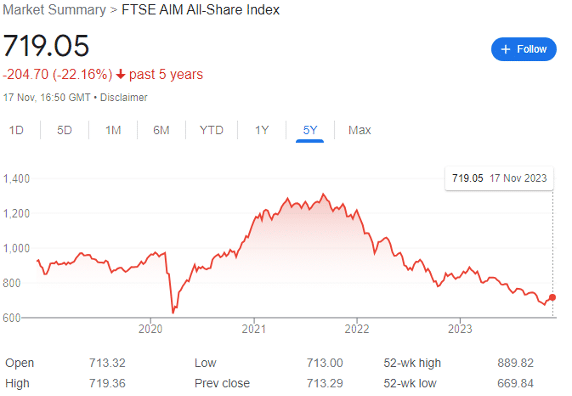The regulators need to do their jobs. Trust in the small cap market is collapsing, and with it, the long-term investing mindset.

At some point, someone has to say it. Enough is enough.
The FTSE AIM market may have bounced off its late October low — but the index has still nearly halved in value since September 2021 — and remains not particularly far from its pandemic mini-crash nadir.

Now of course, there are macroeconomic reasons for this. For instance, interest rates have risen to 5.25% amid CPI inflation that is still more than double the Bank of England’s official 2% target. The UK may yet enter a severe recession in 2024, and accordingly, money has leaked out of risk assets like a sieve.
In fact, AIM continues to lose listed companies, either to private equity due to fundamental under valuations, or because the zombie company of the day has gone bust. And to an extent, that is how the market is supposed to work; high risk, high reward investors are usually eyeing a buyout (often just before a corporate bankruptcy), but the problem is that companies leaving the index are not being replaced.
Yes, you can point the finger at the potential inheritance tax abolition, or else an overly expensive and relatively pointless administrative burden. But my view — and the private view of many analysts — is that the market has got to a point where the regulation simply is not being enforced.
And therefore, potential investors are deserting.
Is the trust gone?
Or in other words: is the market now unregulated? Trust in the RNS system, nominated advisors, and research is at an all-time low. And while there are plenty of investors prepared to take the high risks on offer in the small cap space in return for potentially lucrative rewards, they are not prepared to invest when there is no punishment for companies breaking the rules.
This is a difficult article to write — to start with, I’d rather not attract a lawsuit, so cannot name companies outright.
But let’s consider the fictional Dog Star Minerals. While it had moved to the Main Market when it was sold to a major (for example, Anglo American), the company spent several years lying to investors about its finances.
And when it was sold off for pennies on the dollar, security guards had to be on hand to protect directors from ‘credible threats,’ including CEO Jesus Forest who had sold a dream of a multi-decade asset that would generate billions of pounds of profit.
How about a more recent imaginary example? Imagine an oil and gas company — let’s say JPH — which described itself as the ‘jewel in the crown’ mere months before collapsing into administration and leaving shareholders with nothing.
Let’s consider the illusory WANdance. It made up — literally completely fabricated — over $100 million of bookings — and the CEO had only this to say after the stock collapsed: ‘I am sad to be leaving WANdance after 18 extremely enjoyable years. I remain a passionate supporter and significant shareholder of the Company.’
Maybe Downsea Resources? Another one. This phantastic business released an RNS stating that it had received an unsolicited, very preliminary approach at a huge premium — and four days later (after sucking investors in) it announced information that ‘cast significant doubt on the veracity of the Approach and identity of the potential offeror.’
In fact, this potential offeror had got in contact to say they had no connection to this approach whatsoever. In other words, it was completely made up.

Let’s think about Verticante Minerals. This imaginary company — viewed by many to be safe as houses — decided to casually announce that capex costs at its flagship mine would be rising by ‘at least 35%’ on a random day in October.
Apparently, one day capex costs were fine and the next they were possibly doubling. Shareholders saw their investment crash by 90%, but the entire management team are still being paid hundreds of thousands a year.
And then late last week, another company — let’s call them Blue Air Resources — posted a recent picture of its lithium on site bagged and ready to go. Except this picture was lifted from a random Japanese website and ostensibly taken at some point during the 1990s. And this wasn’t the first suspect photo — another the day before had been taken from an Indian website.
Before this incident, this particular company’s CEO was kicked out of a Telegram Group of investors and then complained about it on the official Twitter handle.
Regulator incompetence We’ve all been there. Your stock drops 20% — but there’s no news. Or it rises 30% — again no news. Then the next day (surprise, surprise) the 7am RNS drops, but clearly, some got the inside scoop long before others.
What does the FCA or LSEG do about the misleading (or just plain lying)? Nothing. It doesn’t care, and then when businesses fail to list on the market, they publicly wonder why. It costs hundreds of thousands of list on the AIM market — but there seem to be few advantages nowadays.
And this is creating a big problem for companies already on the market, because the lack of trust in long term fundamentals as a result of not being able to trust that companies will be held to their mistruths means that the regulators are creating an index where nobody is prepared to hold for the long term, instead trading up and down for a few percent each time.
This means that whenever a gamechanger RNS comes in, there might be a spike, but in 2023 it just ends up reversing to the mean.
The key problem is that the AIM market is regulated by Nominated Advisers — aka NOMADs — and they are usually paid in shares. The CEOs are also often paid in shares. Most marketing is paid in shares. And this creates an obvious problem of bias — though there seems to be no better way of regulating or providing research in the market.
And yes, of course companies need to promote their stock — that’s a key job. But more and more, it seems that companies are getting away with outright lying to investors.
And this investor has had enough.
This article has been prepared for information purposes only by Charles Archer. It does not constitute advice, and no party accepts any liability for either accuracy or for investing decisions made using the information provided.
Further, it is not intended for distribution to, or use by, any person in any country or jurisdiction where such distribution or use would be contrary to local law or regulation.

I see you observe the highest journalistic standards in checking your stories with those you write about. Or not.
Your statement that a company – recognisable as us – had lifted an image from a 1990s Japanese source was absolutely false. Not 1990s (duh – nobody was mining lithium in large quantity back then). Not lifted. Not fake. The Japanese company had treated a marketing picture it received as a stock image.
And any other image we put out the day before was not from an Indian website.
And the CEO was joined up by someone to a Telegram group. When he checked it he posted a brief note to the effect that people should not rely on gossip but on RNS releases as there was excessive speculation at the time – and was thrown off the group for being an obvious imposter.
But truth would have spoilt the story.
Hi Andrew,
No idea what you’re talking about – perhaps the fictional Blue Air Resources?
But if this were about Red Rock, then why have all the photos been deleted from the Red Rock Resources Twitter? Please reupload in all their glory.
Best,
Charles
Oh give over. We all saw the photo of you pretending the bags were 1 ton sacks of ore. When it was pointed out they appeared not even 100KG in size, your Twitter nerd said they were and it was just that there was no reference points to judge by. There were men standing by them and they barely reached their knees. Either the men in the photos were 15ft tall or the sacks were not 1Ton. The photo was lifted, people actually proved it by linking to the Japanese website, wich was cached long before your Twitter post.
Further – since the Japanese company in question was formed in 2017, how was this image ever from 1990s? Just bad journalism
Charles, I have been exposing AIM fraud for more than a decade @shareproophets, well over 100 of them. I don’t disagree but 1 caveat, the Red Rock example it was the Japanese company that half inched the image not the other way round and the CEO was booted out of the Telegram Group by its managers for not being bullish enough. RRR is an almighty dog with masses of fleas but on these 2 counts it is not guilty.
Hi Tom,
This is not the first time a photo purported to be from a Red Rock asset has appeared elsewhere (usually on a sketchy site somewhere half-hidden from Google). The company has since removed all of these photos from its Twitter feed.
I will happily remove this part of the article IF Red Rock can post similar photos and a short video clip from the same mines/locations as the originals.
But it looked to me, that the Google cached version of the website and photo was much older than the “fresh” photo used by the fictitious Blue Air on their Twitter account. How does that work, was a time machine involved? Where were these photos used by Blue Air before this date, that meant the Japanese website could pinch them? I thought they were posted as “Breaking News” of the shipment ready to leave? I’m not convinced. Maybe you can elaborate on why you’re so convinced of your version of events, to put us all at ease?
They were also claimed to be 1 Ton sacks, yet didn’t even reach the knees of the men standing right by them. Maybe Blue Air only employs 15ft giants?
The headline for the article “Is the AIM market an unregulated mess?” suggests that AIM is the problem. And in a bearish market where AIM is still underachieving, I can understand that point.
But the issue lies not only with AIM, indeed the problems may be exacerbated with Main Market small caps. There are some absolutely outrageous goings on with minimal oversight from the boards.
I enjoyed a recent interview you gave on a podcast, with some interesting insight into your investing strategy. But that podcast is run by the type of PR remunerated in shares that you complain of.
As for Mr Bell’s protestations, there were two photos published on X which had appeared on two separate websites. To have one photo used by another company on the premise it was a stock photo may be regarded as a misfortune; to have two looks like carelessness.
I agree that the markets are a murky and sometime lawless world, and I do think that they would benefit from a clean up as this would encourage investors to return.
Hi – the research problem in small caps is tricky. Analysts need to be paid for their time, but I am aware I am also part of the ‘system.’ It’s not perfect, but the alternative is that deserving companies get no exposure to retail investors.
As for Red Rock – there’s only so much carelessness investors can accept.
Charles, you have nailed it this time. The shenanigans that goes on is destroying the market like a cancer. I am still hoping to get a big winner – needed to break even due to corruption that has robbed me of a small fortune. Then I am off and would only dabble with pocket money unless this mess gets cleaned up.
Hi Duncan,
While I cannot give advice, my strategy is to allocate at least 50% of excess income to the blue chips, and then a further 5-10% to gold.. Yes they’re boring, but they’re safe.
Then diversify the remaining 40% through your AIM holdings, with some acceptance that some will go awry 🙂
YES KNOWN FOR AGES HOW CORRUPT AIM IS, BUT WHEN YOU THINK YOU HAVE A GOOD COMPANY, THE SHARE PRICE IS CONSTANTLY MANIPULATED BY THE DEALERS, AND OF COURSE, THE SHORTERS WHO SEEM TO BE WORKING TOGETHER. I JUST WANT TO BREAK EVEN, OR WHEN THE COMPANY JOINS AUSSY STOCK MARKET THEN I SWEAR I WILL NEVER EVER INVEST IN AIM OR 250 SO CORRUPT
Yes, I recently published an update to this article where I concur on some of these points.
Charles. Look at the 12 year history of misleading promises and bogus ‘broker research’ on eg a certain Kibo and its offshoots incl Mast and Kat. Look on ADVFN for the only commentary that flagged its sins consistently down the years. Don’t bother with LSE. It ‘bans’ what it calls ‘negative’ comments on companies (Why ? – because it’s a PR firm masquerading as an objective chat board) so there is a permanent ramping bias which has lured in the naive to lose their shirts on many other companies I could name. The FT used to write about the toxic chat boards and could do with an update so as to kick the FCA up the proverbial.
I fully agree, and am planning to launch a series of proposals to revamp the market. Will post on this site when ready, so keep an eye out!